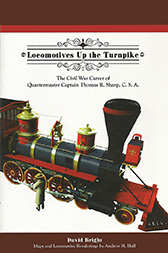“They lay as thick as autumn leaves”

Friday, September 19, 1862, near Sharpsburg, Maryland:

I took the delay to ride over the field of battle. The Rebel dead, even in the woods last occupied by them, was very great. In one place, in front of the position of my corps, apparently a whole regiment had been cut down in line. They lay in two ranks, as straightly aligned as on a dress parade. There must have been a brigade, as part of the line on the left had been buried. I counted what appeared to be a single regiment and found 149 dead in the line and about 70 in front and rear, making over 200 dead in one Rebel regiment. In riding over the field I think I must have seen at least 3,000. In one place for nearly a mile they lay as thick as autumn leaves along a narrow lane cut below the natural surface, into which they seem to have tumbled. Eighty had been buried in one pit, and yet no impression had apparently been made on the unburied host. The cornfield beyond was dotted all over with those killed in retreat. The wounded Rebels had been carried away in great numbers and yet every farmyard and haystack seemed a large hospital. The number of dead horses was high. They lay, like the men, in all attitudes. One beautiful milk-white animal had died in so graceful a position that I wished for its photograph. Its legs were doubled under and its arched neck gracefully turned to one side, as if looking back to the ball-hole in its side. Until you got to it, it was hard to believe the horse was dead. Brigadier General Alpheus S. Williams,
Division Commander, Army of the Potomac
![]()
________________________
Alpheus S. Williams, Milo Milton Quaife (eds.), From the Cannon’s Mouth: The Civil War Letters of General Alpheus S. Williams (Detroit: Wayne State, 1959). Image: Library of Congress.





Andy – I wanted to “like” this because of the General’s evocative prose, but the picture of the dead horse, beautiful as it is, just kind of messed me up.
This is just a tremendous post and shows (as if we didn’t have enough proof) the cost of war, both in human and animal terms.
Thank you.
Also, thank you for including the horse. It may have been my realization some decades ago when I began probing into all these matters that created the Civil War that so many animals were involved too, that brought home just how huge an event the Civil War was, that affected everyone and everything here in the U.S.
But the very glimmer I got of this — and it may well have been my personal introduction to slavery and the Civil War — was reading at age 9 Louisa May Alcott’s Little Men. The African American man of all work around the Plumfield School for Boy, Silas, is ‘captured’ by the boys one autumn night of story telling around the fire, with apples and popcorn. Silas says he doesn’t know any stories, but he could tell about something he never forgot. He proceedes to tell of his experience as a soldier in a battle of the Civil War (and I was not clear as to that, or even what the Civil War was at that time) and his horse. More than one man in this story dies, he was wounded. His horse also dies — he has to shoot him — but had been as much a hero as the other men — Rebel and Union. He cut off a lock of the horse’s mane and had it by him to this very day, in his “old wallet.” He takes it out and shows it to the children.
Love, C.